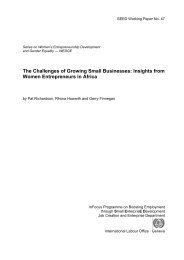manual: women workers' rights and gender equality - International ...
manual: women workers' rights and gender equality - International ...
manual: women workers' rights and gender equality - International ...
Create successful ePaper yourself
Turn your PDF publications into a flip-book with our unique Google optimized e-Paper software.
Briefing Note 1 Training Methods<br />
This briefing note explains how to use the following training methods: plenary discussions, group<br />
work, role plays, case studies or stories <strong>and</strong> evaluation.<br />
Plenary Discussions<br />
Discussions in plenary are important to:<br />
• Ensure everybody underst<strong>and</strong>s the main points <strong>and</strong> key messages.<br />
• Clarify questions.<br />
• Obtain consensus on main directions or obtain detailed information needed for setting main<br />
directions.<br />
• Clearly define for yourself <strong>and</strong> the participants the aim <strong>and</strong> subject for discussion at the start<br />
<strong>and</strong> at the end of each session.<br />
• Enable as many participants as possible to join in the discussion. Try to be aware of<br />
participants who have not spoken. Think of ways to encourage them to join in without putting<br />
them under pressure, for example by asking <strong>women</strong> to respond, if they have been quiet. You<br />
can also ask for views from the young <strong>and</strong> the old.<br />
• Ensure that you as the trainer (or any other participant) do not dominate the discussions, or<br />
present too much your own opinion. Part of the trainer’s role is to guide the discussions. Try to<br />
encourage participants to listen to each other <strong>and</strong> pay attention to the progress of the<br />
discussion. If the discussion starts to w<strong>and</strong>er to other subjects, note this for future sessions but<br />
bring the discussion back to the main issue by asking direct questions.<br />
• Ask participants to lead or chair a discussion. This promotes ‘ownership’.<br />
• Prepare yourself for existing differences of opinion which might come up during the discussion<br />
as there can be strong alternative views or clashes of opinion. Disagreements can actually<br />
sharpen the issues under discussion. At the same time, ensure respect towards all participants<br />
at all times. If some participants ridicule the opinions of others, cut them short <strong>and</strong> point out<br />
that this is unacceptable group behaviour.<br />
• Pay attention to time management.<br />
• Listen carefully to what participants say, not what you expect them to say. Concentrate on what<br />
is actually happening, not on what you planned to happen.<br />
• Prepare for the discussion but do not dominate it. Use your ideas <strong>and</strong> information to move the<br />
discussion along <strong>and</strong> help to clarify points.<br />
Group work<br />
During <strong>gender</strong> training workshops, small group work is one of the main educational methods as<br />
‘learning by sharing experience’ is likely to be more effective than ‘learning by being told. Group<br />
work is an active method <strong>and</strong> encourages cooperation. It allows for more speaking time by<br />
everybody <strong>and</strong> the build-up of alliances <strong>and</strong> networking between participants. It enables less<br />
confident participants to become involved in discussion. The reporting back after the group work<br />
provides an effective way of structuring the discussion <strong>and</strong> drawing out the main points on which<br />
consensus can be reached.<br />
The division of participants for the group work exercises is of major importance <strong>and</strong> should not be<br />
left to the participants themselves or to chance. The trainers should divide the participants into<br />
balanced groups. Criteria to be taken into consideration are: language ability, sex, background,<br />
grade, area of expertise, age. Sometimes it will be useful to group participants by common<br />
135

















